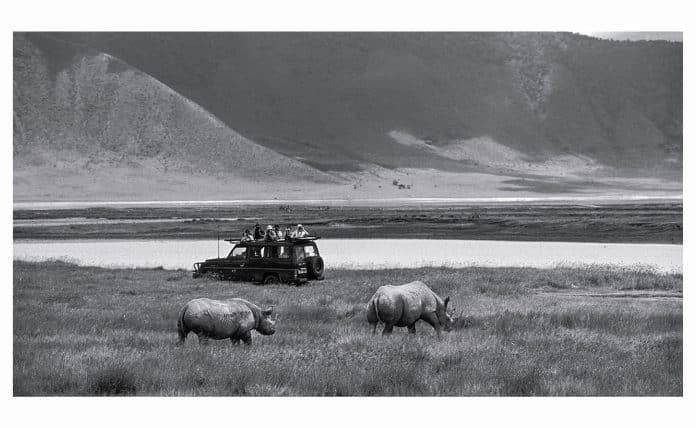A Wildlife Paradise: Discover the Best Time to Visit Tanzania for an Unforgettable Safari Adventure
With its vast savannahs, diverse wildlife, and stunning landscapes, Tanzania is undoubtedly a wildlife paradise that offers an unforgettable safari adventure. Whether you are a nature enthusiast or an adventure seeker, Tanzania has something for everyone. But when is the best time to visit Tanzania?
Timing is key when planning a safari in Tanzania. The wildlife viewing experience can vary depending on the season, and it’s essential to choose the right time to witness nature’s incredible spectacle. From the Great Migration in the Serengeti to the remarkable birdlife in Lake Manyara National Park, each season brings its unique charm.
The best time to visit Tanzania for wildlife sightings
When asking the question, what is the best time to visit Tanzania ? It’s necessary to note that Tanzania’s wildlife is abundant throughout the year, but certain times offer better opportunities for sightings and unique experiences. The dry season, from June to October, is widely regarded as the best time to visit Tanzania for wildlife. During this period, the vegetation is less dense, making it easier to spot animals, and wildlife congregates around water sources, providing excellent game viewing opportunities. The dry season also coincides with the Great Migration, a remarkable natural spectacle where millions of wildebeest and zebra traverse the Serengeti in search of greener pastures.
On the other hand, the wet season, from November to May, offers its own set of attractions. While the rain can make some areas inaccessible, it brings luscious green landscapes and an abundance of newborn animals. The wet season is also the best time to visit Tanzania for birdwatching, as migratory birds flock to Tanzania, adding vibrant colors to the already diverse wildlife.
Weather patterns in Tanzania and their impact on safari experiences

Understanding the weather patterns in Tanzania is crucial for planning a safari adventure. Tanzania experiences two primary seasons: the dry season and the wet season. The dry season, which runs from June to October, is characterized by warm days, cool nights, and minimal rainfall. This season is the best time to visit Tanzania for game drives, as animals gather around water sources, making them easier to spot.
In contrast, the wet season, from November to May, brings more rainfall and lush vegetation. While the rain can make some areas muddy and difficult to access, it also creates a beautiful green landscape and an abundance of food for wildlife. The wet season is an excellent time for birdwatchers, as many migratory birds arrive in Tanzania during this time.
When planning your safari, it’s essential to consider the weather patterns and how they may impact your experience. The dry season offers excellent game viewing opportunities and is the best time to witness the Great Migration. However, the wet season can be equally rewarding, with newborn animals and vibrant birdlife.
The Great Migration: Witnessing the spectacle of wildebeest and zebra migration
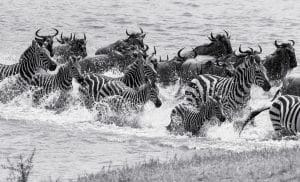
One of the most awe-inspiring events in the animal kingdom is the Great Migration in Tanzania. Every year, millions of wildebeest and zebra migrate across the vast plains of the Serengeti in search of fresh grazing land. This incredible journey is driven by the changing seasons and the need for food and water.
The Great Migration typically starts in the southern Serengeti, where the wildebeest give birth to their young. As the dry season progresses, the herds start moving north, crossing crocodile-infested rivers and facing other predators along the way. By July, they reach the northern Serengeti and eventually cross into the Maasai Mara in Kenya.
The best time to witness the Great Migration in Tanzania is during the dry season, from June to October. During this period, the herds are concentrated in the Serengeti, making it easier to witness the river crossings and predator-prey interactions. It’s an awe-inspiring spectacle that showcases the raw power of nature and the circle of life.
Off-peak seasons: Exploring Tanzania’s wildlife without the crowds
While the dry season and the Great Migration attract a significant number of visitors to Tanzania, there are also off-peak seasons that offer unique advantages. Visiting during these periods allows you to explore Tanzania’s wildlife without the crowds and provides a more intimate safari experience.
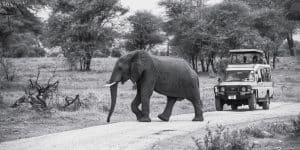
The months of November and December mark the beginning of the short rains, and while the number of visitors decreases during this time, the wildlife is still abundant. The rain brings new life to the savannahs, with an explosion of vibrant flowers and an influx of newborn animals.
Another off-peak season is from March to May, which is the long rainy season. While some lodges and camps may close during this time, those that remain open offer discounted rates, making it an attractive option for budget-conscious travelers. The wet season brings its own charm, with lush green landscapes and fewer crowds, allowing you to have a more exclusive wildlife experience.
Wildlife highlights in different seasons: Lions, elephants, leopards, and more
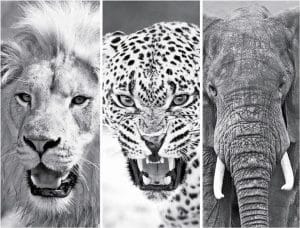
Tanzania is home to a diverse range of wildlife, including lions, elephants, leopards, and many other fascinating species. The best time to spot these animals can vary depending on the season and their natural behaviors.
During the dry season, when water sources are scarce, wildlife congregates around rivers and waterholes, making it easier to spot them. This is an excellent time to witness predators in action, as they take advantage of the concentrated prey. Lions, in particular, are often seen resting near water sources or hunting in groups.
The wet season, on the other hand, brings an abundance of food and water, leading to a higher density of wildlife. This is an excellent time to see newborn animals, as many species give birth during this period. The lush vegetation also provides ample hiding spots for leopards and other elusive animals.
No matter the season, Tanzania offers incredible wildlife sightings. Whether you’re an avid birder, a big cat enthusiast, or simply fascinated by the diversity of African wildlife, there’s something for everyone in this wildlife paradise.
Planning your safari: Choosing the right accommodation and safari packages
When planning a safari in Tanzania, choosing the right accommodation and safari packages is crucial for a memorable experience. Tanzania offers a wide range of accommodation options, from luxury lodges to tented camps and budget-friendly campsites. The choice depends on your budget, preferences, and the level of comfort you seek.
Luxury lodges provide a high level of comfort and amenities, with spacious rooms, gourmet meals, and exceptional service. They often offer guided game drives and other activities, ensuring a luxurious and hassle-free safari experience.
Tented camps, on the other hand, offer a more authentic and immersive experience. These camps are often located in remote areas, allowing you to be closer to nature. While the accommodations may be simpler, the experience of staying in a tented camp surrounded by the sounds of the wilderness is truly unforgettable.
For budget-conscious travelers, there are also campsites available in national parks and conservation areas. These campsites offer basic facilities but allow you to experience the beauty of Tanzania’s wildlife without breaking the bank.
When choosing a safari package, consider the duration of the safari, the parks you want to visit, and the activities you wish to participate in. Some packages offer a combination of game drives, walking safaris, and cultural interactions, allowing you to have a well-rounded safari experience.
Photography tips for capturing Tanzania’s wildlife in its natural habitat
Tanzania’s wildlife and landscapes provide a photographer’s paradise. Capturing the beauty of this captivating destination requires careful planning and understanding of the animals’ behavior and the environment.
First and foremost, invest in a good quality telephoto lens, as it allows you to capture close-up shots of wildlife from a safe distance. A lens with a focal length of 200-400mm is ideal for capturing the intricate details of animals in their natural habitat.
Lighting is crucial in photography, and Tanzania’s golden hour provides the best lighting conditions for capturing stunning images. The golden hour refers to the period just after sunrise and just before sunset when the light is soft and warm, creating a magical atmosphere.
Patience is key when photographing wildlife. Animals can be unpredictable, and it may take time to capture the perfect shot. Spend time observing their behavior and anticipate their movements to capture unique and compelling images.
Lastly, respect the animals and their natural environment. Maintain a safe distance and avoid disturbing their natural behaviors. Remember, the goal is to capture their beauty without causing any harm or stress to them.
Cultural experiences: Interacting with local tribes and communities
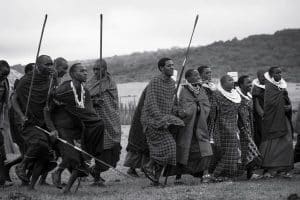
Tanzania is not only known for its wildlife but also for its rich cultural heritage. Interacting with local tribes and communities provides a unique opportunity to learn about their traditions, customs, and way of life.
The Maasai people, known for their distinctive clothing and beadwork, are one of Tanzania’s most iconic tribes. Visiting a Maasai village allows you to gain insight into their traditional lifestyle, from their cattle herding practices to their unique ceremonies and dances.
Another fascinating cultural experience is visiting the Hadzabe tribe, one of the last hunter-gatherer communities in Africa. Spending time with the Hadzabe allows you to learn about their hunting techniques, medicinal plants, and their deep connection with nature.
Engaging with local communities not only enriches your safari experience but also contributes to the sustainable development of these communities. By supporting local initiatives and purchasing locally made crafts, you can have a positive impact on the lives of the people you encounter.
Making the most of your safari adventure in Tanzania
Tanzania offers a truly unforgettable safari adventure, with its vast savannahs, diverse wildlife, and stunning landscapes. Whether you choose to visit during the dry season to witness the Great Migration or explore the wet season’s lush green landscapes, Tanzania guarantees an awe-inspiring experience.
Understanding the best time to visit for wildlife sightings and considering the weather patterns will help you plan your safari accordingly. Whether you’re a wildlife enthusiast, a birdwatcher, or a photography enthusiast, Tanzania’s wildlife will leave you in awe.
Choosing the right accommodation and safari packages ensures a comfortable and tailored experience. Whether you opt for luxury lodges, tented camps, or budget-friendly campsites, Tanzania offers a wide range of options to suit every traveler’s preferences.
Lastly, don’t forget to immerse yourself in Tanzania’s rich culture by engaging with local tribes and communities. These cultural experiences add depth and authenticity to your safari adventure and allow you to connect with the people who call this remarkable country home.
Prepare yourself for an unforgettable safari adventure in Tanzania, where nature’s incredible spectacle awaits. Witness the Great Migration, capture stunning wildlife photographs, and create lasting memories in this wildlife paradise. Tanzania is calling, and your safari adventure awaits.
For more articles related to Things to Do in Tanzania (Zanzibar), click here!
























